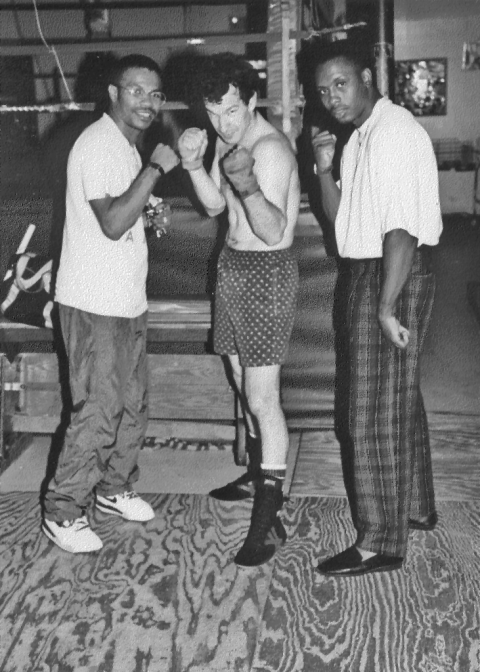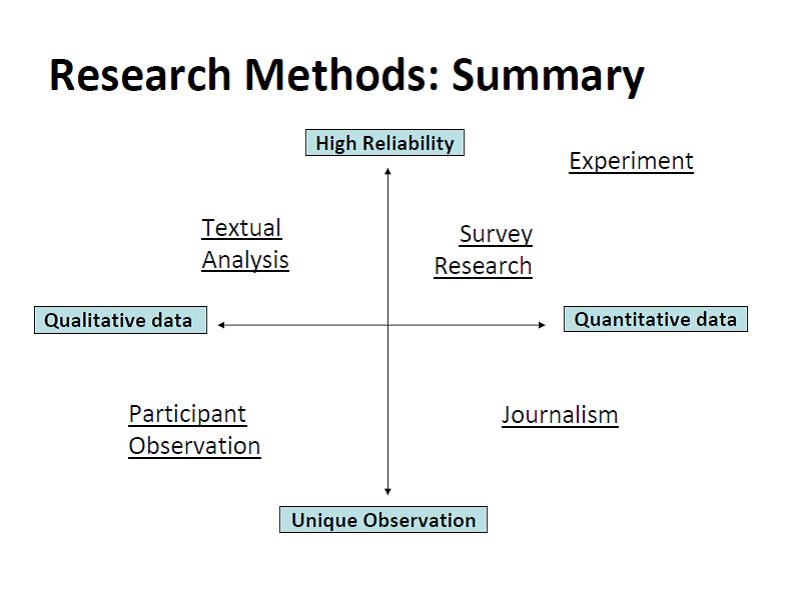2.2. Research Methods
Sociologists examine the world, see a problem or interesting pattern, and set out to study it. They use research methods to design a study — perhaps a positivist, quantitative method for conducting research and obtaining data, or perhaps an ethnographic study utilizing an interpretive framework. Planning the research design is a key step in any sociological study. When entering a particular social environment, a researcher must be careful. There are times to remain anonymous and times to be overt. There are times to conduct interviews and times to simply observe. Some participants need to be thoroughly informed; others should not know that they are being observed. A researcher would not stroll into a crime-ridden neighbourhood at midnight, calling out, “Any gang members around?” And if a researcher walked into a coffee shop and told the employees they would be observed as part of a study on work efficiency, the self-conscious, intimidated baristas might not behave naturally. The unique nature of human research subjects is that they can react to the researcher and change their behaviour under observation.
Making Connections: Sociological Research
The Hawthorne Effect

In the 1920s, leaders of a Chicago factory, called Hawthorne Works, commissioned a study to determine whether or not changing certain aspects of working conditions could increase or decrease worker productivity. Sociologists were interested in the increased productivity of a test group when the lighting of their workspace was improved. They were surprised however when productivity improved if the lighting of the workspace was dimmed, as well. In fact almost every change of independent variable — lighting, work breaks, work hours — resulted in an improvement of productivity. But when the study was over, productivity dropped again.
Why did this happen? In 1953, Henry A. Landsberger analyzed the study results to answer this question. He realized that employees’ productivity increased because sociologists were paying attention to them. The sociologists’ presence influenced the study results. Worker behaviours were altered not by the lighting but by the study itself. From this, sociologists learned the importance of carefully planning their roles as part of their research design (Franke & Kaul, 1978). Landsberger called the workers’ response the Hawthorne effect — people change their behaviour when they know they are being watched as part of a study.
The Hawthorne effect is unavoidable in some research. In many cases, sociologists have to make the purpose of the study known for ethical reasons. Subjects must be aware that they are being observed, and a certain amount of artificiality may result (Sonnenfeld, 1985). Making sociologists’ presence invisible is not always realistic for other reasons. That option is not available to a researcher studying prison behaviours, early education, or the Ku Klux Klan. Researchers cannot just stroll into prisons, kindergarten classrooms, or Ku Klux Klan conclaves and unobtrusively observe behaviours. In situations like these, other methods are needed. All studies shape the research design, while research design simultaneously shapes the studies’ outcomes. Researchers choose methods that best suit their study topic and that fit with their overall goal for the research.
In planning a study’s design, sociologists generally choose from four widely used methods of social investigation: survey, experiment, field research, and textual or secondary data analysis (or use of existing sources). Every research method comes with pluses and minuses, and the topic of study strongly influences which method or methods are put to use.
1. Surveys
As a research method, a survey collects data from subjects who respond to a series of questions about behaviours and opinions, often in the form of a written questionnaire. The survey is one of the most widely used sociological research methods. The standard survey format allows individuals a level of anonymity in which they can express personal ideas.

At some point or another, everyone responds to some type of survey. The Statistics Canada census is an excellent example of a large-scale survey intended to gather sociological data. Customers also fill out questionnaires on-line and at stores or promotional events, responding to questions such as “How did you hear about the event?” and “Were the staff helpful?” Many people have probably picked up the phone and heard a caller ask them to participate in a political poll or similar type of survey: “Do you eat hot dogs? If yes, how many per month?” Not all surveys would be considered sociological research. Marketing polls help companies refine their marketing goals and strategies; they are generally not conducted as part of a scientific study, meaning they are not designed to test a hypothesis or to contribute knowledge to the field of sociology. The results are not published in a refereed scholarly journal where design, methodology, results, and analyses are vetted.
Often, polls on TV do not reflect a general population, but are merely answers from a specific show’s audience. Polls conducted by programs such as American Idol or Canadian Idol represent the opinions of fans, but are not particularly scientific. A good contrast to these are the Bureau of Broadcast Measurement (BBM) (now called Numeris) ratings, which determine the popularity of radio and television programming in Canada through scientific market research. Their researchers ask a large random sample of Canadians, age 12 and over, to fill out a television or radio diary for one week, noting the times and the broadcasters they listened to or viewed. Based on this methodology they are able to generate an accurate account of media consumers preferences, which are used to provide broadcast ratings for radio and television stations and define the characteristics of their core audiences.
Sociologists conduct surveys under controlled conditions for specific purposes. Surveys gather different types of information from people. While surveys are not great at capturing the ways people really behave in social situations, they are a great method for discovering how people feel and think — or at least how they say they feel and think. Surveys can track attitudes and opinions, political preferences, individual behaviours (e.g., sleeping, driving, dietary, or texting habits), or factual social background information (e.g., employment status, income, and education levels). A survey targets a specific population, people who are the focus of a study, such as Canadian citizens, university athletes, international students, or teenagers living with type 1 (juvenile-onset) diabetes.
Most researchers choose to survey a small sector of the population, or a sample: That is, a manageable number of subjects who represent a larger population. The success of a study depends on how well a population is represented by the sample. In a random sample, every person in a population has the same chance of being chosen for the study. According to the laws of probability, random samples can be used to represent the population as a whole. The larger the sample size, the more accurate the results will be in characterizing the population being studied. For practical purposes, however, a sample size of 1,500 people will give acceptably accurate results even if the population being researched was the entire adult population of Canada. For instance, an Ipsos Reid poll, if conducted as a nationwide random sampling, should be able to provide an accurate estimate of public opinion whether it contacts 1,500 or 10,000 people.
Typically surveys will include a figure that gives the margin of error of the survey results. This is a measure of reliability. Based on probabilities, this will give a range of values within which the true value of the population characteristic will be. This figure also depends on the size of a sample. For example, a political poll based on a sample of 1,500 respondents might state that if an election were called tomorrow the Conservative Party would get 30% of the vote plus or minus 2.5% based on a confidence interval of 95%. That is, there is a 5% chance that the true vote would fall outside of the range of 27.5% to 32.5%, or 1 time out of 20 if pollsters were to conduct the poll 20 times. If the poll was based on a sample of 1,000 respondents, the margin of error would be higher, plus or minus 3.1%. This is significant, of course, because if the Conservatives are polling at 30% and the Liberals are polling at 28% the poll would be inconclusive about which party is actually ahead with regard to actual voter preferences.
Problems with accuracy or reliability can result if sample sizes are too small because there is a stronger chance the sample size will not capture the actual distribution of characteristics of the whole population. In small samples the characteristics of specific individuals have a greater chance of influencing the results. The reliability of surveys can also be threatened when part of the population is inadvertently excluded from the sample (e.g., telephone surveys that rely on land lines exclude people that use only cell phones) or when there is a low response rate. There is also a question of what exactly is being measured by the survey. This is a question of validity. Does asking whether a voter would choose the Conservatives, Liberals, NDP, or Greens if an election was held today accurately measure their actual voting behaviour on election day? In the BC election of 2013, polls found that the NDP had the largest popular support but on election day many people who said they would vote NDP did not actually vote, which resulted in a Liberal majority government.
After selecting subjects, the researcher develops a specific plan to ask a list of standardized questions and record responses. It is important to inform subjects of the nature and purpose of the study upfront. If they agree to participate, researchers thank the subjects and offer them a chance to see the results of the study if they are interested. The researchers present the subjects with an instrument or means of gathering the information. A common instrument is a structured written questionnaire in which subjects answer a series of set questions. For some topics, the researcher might ask yes-or-no or multiple-choice questions, allowing subjects to choose possible responses to each question.
This kind of quantitative data — research collected in numerical form that can be counted — is easy to tabulate. Just count up the number of “yes” and “no” answers or tabulate the scales of “strongly agree,” “agree,” “disagree,” etc. responses, and chart them into percentages. This is also the chief drawback of questionnaires, however: their artificiality. The artificial nature of the questions affects their validity. In real life, there are rarely any unambiguously yes or no answers. Questionnaires can also ask more complex questions with more complex answers beyond yes, no, agree, strongly agree, or another option next to a check box. For example, How do you plan to use your university education? Why do you follow Justin Bieber on Twitter? In those cases, the answers are more nuanced, varying from person to person. Those types of survey questions require short essay responses, and participants willing to take the time to provide those answers will convey personal information about their beliefs, views, and attitudes that will need to be interpreted and coded by the researcher.
Some topics that reflect internal subjective perspectives are impossible to quantify simply. Sometimes they can be sensitive and difficult to discuss with a researcher straightforwardly. Sometimes they are nuanced and ambiguous. People might not know how to answer a question on a topic, but the way in which they formulate their response can be illuminating to sociologists. This type of information is qualitative data — results that are subjective and often based on what is experienced in a natural setting. Qualitative information is harder to organize and tabulate. The researcher will end up with a wide range of responses, some of which may be surprising and unpredictable in advance. Nevertheless, the responses are a richer source of primary data on a topic.
An interview is a one-on-one conversation between the researcher and the subject, and is another way of conducting surveys on a topic. Interviews are similar to the short answer questions on surveys in that the researcher asks subjects a series of questions. They can be quantitative if the questions are standardized and have numerically quantifiable answers: Are you employed? (Yes=0, No=1); On a scale of 1 to 5, how would you describe your level of optimism? They can also be qualitative if participants are free to respond as they wish, without being limited by predetermined choices. In the back-and-forth conversation of an interview, a researcher can ask for clarification, spend more time on a subtopic, or ask additional questions. In an interview, a subject will ideally feel free to open up and answer questions that are often complex. There are no right or wrong answers. The subject might not even know how to answer the questions honestly. Questions such as “How did society’s view of alcohol consumption influence your decision whether or not to take your first sip of alcohol?” or “Did you feel that the divorce of your parents would put a social stigma on your family?” involve so many factors that the answers are difficult to categorize. A researcher needs to avoid steering or prompting the subject to respond in a specific way; otherwise, the results will prove to be unreliable. Obviously, a sociological interview is also not supposed to be an interrogation. The researcher will benefit from gaining a subject’s trust by empathizing or commiserating with a subject, and by listening without judgement.
2. Experiments
People often test personal social theories. “If I study at night and review in the morning, I’ll improve my retention skills.” Or, “If I stop drinking soda, I’ll feel better.” Cause and effect. If this, then that. When one tests a theory, the results either prove or disprove a hypothesis. On an individual level these tests are often of dubious value, of course. If one fails a test once using a particular study technique, it is not likely that one will try the same method 100 more times to make sure. It is also not likely that one rigorously controls the experimental conditions to make sure that it is studying at night and not some other factor that produces the results. However the underlying idea is the same as that used in sociological experiments. One way sociological researchers test social theories is by conducting an experiment, meaning they test a hypothesis by introducing a variable to a control group and an experimental group under controlled circumstances and compare the outcomes — a scientific approach.
There are two main types of experiments in sociology: lab-based experiments, and natural or field experiments. In a lab setting the research can be controlled so that, perhaps, more data can be recorded in a certain amount of time. In a natural or field-based experiment, the generation of data cannot be controlled, but the information might be considered more accurate since it was collected without interference or intervention by the researcher. As a research method, either type of sociological experiment is useful for testing if-then statements: if a particular thing happens, then another particular thing will result.
To set up a lab-based experiment, sociologists create artificial situations that allow them to manipulate variables. Classically, the sociologist selects a set of people with similar characteristics, such as age, class, race, or education. Those people are divided into two groups. One is the experimental group and the other is the control group. The experimental group is exposed to the independent variable(s) and the control group is not. This is similar to pharmaceutical drug trials in which the experimental group is given the test drug and the control group is given a placebo or sugar pill.
Making Connections: Sociological Research
An Experiment in Action: Mincome

A real-life example will help illustrate the field experimental process in sociology. Between 1974 and 1979 an experiment was conducted in the small town of Dauphin, Manitoba (the “garden capital of Manitoba”). Each family received a modest monthly guaranteed income — a “mincome” — equivalent to a maximum of 60% of the “low-income cut-off figure” (a Statistics Canada measure of poverty, which varies with family size). The income was 50 cents per dollar less for families who had incomes from other sources. Families earning over a certain income level did not receive mincome. Families that were already collecting welfare or unemployment insurance were also excluded. The test families in Dauphin were compared with control groups in other rural Manitoba communities on a range of indicators such as number of hours worked per week, school performance, high school drop out rates, and hospital visits (Forget, 2011). A guaranteed annual income was seen at the time as a less costly, less bureaucratic public alternative for addressing poverty than the existing employment insurance and welfare programs. Today it is an active proposal being considered in Switzerland (Lowrey, 2013).
Intuitively, it seems logical that lack of income is the cause of poverty and poverty-related issues. One of the main concerns, however, was whether a guaranteed income would create a disincentive to work. The concept appears to challenge the principles of the Protestant work ethic (see the discussion of Max Weber in Chapter 1. An Introduction to Sociology). The study did find very small decreases in hours worked per week: about 1% for men, 3% for married women, and 5% for unmarried women. Forget (2011) argues this was because the income provided an opportunity for people to spend more time with family and school, especially for young mothers and teenage girls. There were also significant social benefits from the experiment, including better test scores in school, lower high school drop out rates, fewer visits to hospital, fewer accidents and injuries, and fewer mental health issues.
Ironically, due to lack of guaranteed funding (and lack of political interest by the late 1970s), the data and results of the study were not analyzed or published until 2011. The data were archived and sat gathering dust in boxes. The mincome experiment demonstrated the benefits that even a modest guaranteed annual income supplement could have on health and social outcomes in communities. People seem to live healthier lives and get a better education when they do not need to worry about poverty. In her summary of the research, Forget notes that the impact of the income supplement was surprisingly large given that at any one time only about a third of the families were receiving the income and, for some families, the income amount would have been very small. The income benefit was largest for low-income working families, but the research showed that the entire community profited. The improvement in overall health outcomes for the community suggest that a guaranteed income would also result in savings for the public health system.
To test the benefits of tutoring, for example, the sociologist might expose the experimental group of students to tutoring while the control group does not receive tutoring. Then both groups would be tested for differences in performance to see if tutoring had an effect on the experimental group of students. In a case like this, the researcher would not want to jeopardize the accomplishments of either group of students, so the setting would be somewhat artificial. The test would not be for a grade reflected on their permanent record, for instance.
The Stanford Prison Experiment is perhaps one of the most famous sociological field experiments ever conducted. In 1971, 24 healthy, middle-class male university students were selected to take part in a simulated jail environment to examine the effects of social setting and social roles on individual psychology and behaviour. They were randomly divided into 12 guards and 12 prisoners. The prisoner subjects were arrested at home and transported, blindfolded, to the simulated prison in the basement of the psychology building on the campus of Stanford University. Within a day of arriving the prisoners and the guards began to display signs of trauma and sadism respectively. After some prisoners revolted by blockading themselves in their cells, the guards resorted to using increasingly humiliating and degrading tactics to control the prisoners through psychological manipulation. The experiment had to be abandoned after only six days because the abuse had grown out of hand (Haney, Banks, & Zimbardo, 1973). While the insights into the social dynamics of authoritarianism it generated were fascinating, the Stanford Prison Experiment also serves as an example of the ethical issues that emerge when experimenting on human subjects. It was also not a true experiment in the sense that there was no comparison between a control group and the experimental group.
3. Field Research

The work of sociology rarely happens in limited, confined experimental spaces. Sociologists seldom study subjects in their own offices or laboratories. Rather, sociologists go out into the world. They meet subjects where they live, work, and play. Field research refers to gathering primary data from a natural environment without doing a lab experiment or a survey. It is a research method suited to an interpretive approach rather than to positivist approaches. To conduct field research, the sociologist must be willing to step into new environments and observe, participate, or experience those worlds. In fieldwork, the sociologists, rather than the subjects, are the ones out of their element. The researcher interacts with or observes a person or people, gathering data along the way. The key point in field research is that it takes place in the subject’s natural environment, whether it is a coffee shop or tribal village, a homeless shelter or a boxing club, a hospital or an airport, a mall or a beach resort.
While field research often begins in a specific setting, the study’s purpose is to observe specific behaviours in that setting. Fieldwork is optimal for observing how people behave. It is less useful, however, for developing causal explanations of why they behave that way. From the small size of the groups studied in fieldwork, it is difficult to make predictions or generalizations to a larger population. Similarly, there are difficulties in gaining an objective distance from research subjects. It is difficult to know whether another researcher would see the same things or record the same data. There are three types of field research: participant observation, ethnography, and the case study.
Making Connections: Sociology in the Real World
When Is Sharing Not Such a Good Idea?

Choosing a research methodology depends on a number of factors, including the purpose of the research and the audience for whom the research is intended. The type of research that might go into producing a government policy document on the effectiveness of safe injection sites for reducing the public health risks of intravenous drug use, would be different than exploratory research into the meaning of drug use in specific subcultures. Public administrators likely want “hard” (i.e., quantitative) evidence of high reliability to help them make a policy decision. The most reliable data would come from an experimental research model in which a control group can be compared with an experimental group using quantitative measures.
This approach has been used by researchers studying InSite in Vancouver (Marshall et al., 2011; Wood et al., 2006). InSite is a supervised safe-injection site where heroin addicts and other intravenous drug users can go to inject drugs in a safe, clean, supervised environment. Clean needles are provided and health care professionals are on hand to intervene in the case of overdoses or other medical emergency. It is a controversial program both because heroin use is against the law (the facility operates through a federal ministerial exemption) and because the heroin users are not obliged to quit using or seek therapy. To assess the effectiveness of the program, researchers compared the risky usage of drugs in populations before and after the opening of the facility and geographically near and distant to the facility. The results from the studies have shown that InSite has reduced both deaths from overdose and risky behaviours, such as the sharing of needles, without increasing the levels of crime associated with drug use and addiction.
On the other hand, if the research question is more exploratory, the more nuanced approach of fieldwork is more appropriate. Graduate student Andrew Ivsins at the University of Victoria wanted to study the reasons why individuals in the crack smoking subculture engage in the risky activity of sharing pipes despite the known risks. The research needed to focus on the subcultural context, rituals, and meaning of sharing pipes, and why these phenomena override known health concerns. Ivsins studied the practice of sharing pipes among 13 habitual users of crack cocaine in Victoria, B.C. (Ivsins, 2010; Ivsins, Roth, Benoit, Fischer, 2013). He met crack smokers in their typical setting downtown, and used an unstructured interview method to try to draw out the informal norms that lead to sharing pipes. One factor he discovered was the bond that formed between friends or intimate partners when they shared a pipe. He also discovered that there was an elaborate subcultural etiquette of pipe use that revolved around the benefit of getting the crack resin smokers left behind. Both of these motives tended to outweigh the recognized health risks of sharing pipes (such as hepatitis) in the decision making of the users. This type of research was valuable in illuminating the unknown subcultural norms of crack use that could still come into play in a harm reduction strategy, such as distributing safe crack kits to addicts.
Participant Observation
Loïc Wacquant is a French sociologist who grew up in Montpellier in the south of France, but when he came to the U.S. to study life in Chicago’s south side ghetto he joined the Woodlawn boxing gym, as its only white member, “seeking an observation point from which to scrutinize, listen to, and touch up-close the everyday reality of the black American ghetto” (Wacquant, 2004). It was by accident then that he started his research into boxing. Over a period of three years of intensive practice he became an accomplished apprentice boxer, which also enabled him to participate in the lives of the club members, “accompany[ing] them in their everyday peregrinations outside of it, in search of a job or an apartment, hunting for bargains in ghetto stores, in their hassles with their wives, the local welfare office, or the police, as well as cruising with their “homies” from the fearsome housing projects nearby.” What he discovered was the “highly codified nature of pugilistic violence,” the various methods of building, risking, and protecting the boxer’s “bodily capital,” and the deeply embedded ways in which the boxing gym was integrated into the habitus of ghetto life. Wacquant coined the term carnal sociology to refer to a type of sociology that studies the social world from the point of view of the bodies and bodily practices of the participants (Wacquant, 2015).

Wacquant had conducted a form of study called participant observation, in which researchers join people and participate in a group’s routine activities for the purpose of observing them within that context. This method lets researchers study a naturally occurring social activity without imposing artificial or intrusive research devices, like fixed questionnaire questions, onto the situation. A researcher might go to great lengths to get a firsthand look into a trend, institution, or behaviour. Researchers temporarily put themselves into “native” roles and record their observations. A researcher might work as a waitress in a diner, or live as a homeless person for several weeks, or ride along with police officers as they patrol their regular beat. Often, these researchers try to blend in seamlessly with the population they study, and they may not disclose their true identity or purpose if they feel it would compromise the results of their research.
At the beginning of a field study, researchers often have a question that cannot be answered from the secondary literature: “What really goes on in the kitchen of the most popular diner on campus?” “What is it like to be homeless?” or “What is hip hop subculture like in the 21st century?” Participant observation is a useful method if the researcher wants to explore a certain environment from the inside. Field researchers simply want to observe and learn. In such a setting, the researcher will be alert and open-minded to whatever happens, recording all observations accurately. Soon, as patterns emerge, questions will become more specific, observations will lead to hypotheses, and hypotheses will guide the researcher in shaping data into results.
Loïc Wacquant was upfront about his mission. The boxers of the Woodland’s club knew why he was in their midst. But some sociologists prefer not to alert people to their presence. The main advantage of covert participant observation is that it allows the researcher access to authentic, natural behaviours of a group’s members. The challenge, however, is gaining access to a setting without disrupting the pattern of others’ behaviour. Becoming an inside member of a group, organization, or subculture takes time and effort. Researchers must pretend to be something they are not. The process could involve role playing, making contacts, networking, or applying for a job. Once inside a group, some researchers spend months, or even years, pretending to be one of the people they are observing. However, as observers, they cannot get too involved. They must keep their purpose in mind and apply the sociological perspective. That way, they illuminate social patterns that are often unrecognized. Because information gathered during participant observation is mostly qualitative, rather than quantitative, the end results are often descriptive or interpretive. The researcher might present findings in an article or book, describing what they witnessed and experienced.
One of the most famous studies of this sort was Rosenhan’s (1973), “On Being Sane in Insane Places.” Unbeknownst to staff, Rosenhan and eight of his colleagues gained admission as patients into 12 different psychiatric hospitals. They wanted to test whether, and how, sanity could be distinguished from insanity in the institutions that had been created to make this distinction, and how people are treated on the basis of that distinction. As Rosenhan put it, although people generally believe they can tell the normal from the abnormal, “there are a great deal of conflicting data on the reliability, utility, and meaning of such terms as ‘sanity,’ ‘insanity,’ ‘mental illness,’ and ‘schizophrenia.'” Despite their normal behaviour, the pseudo-patients were not detected. Rosenhan noted that when diagnoses had been made, it was very difficult to reverse them. “Once a person is designated abnormal, all of his other behaviours and characteristics are coloured by that label.” Moreover, the psychological consequences for the pseudo-patients was distressing and far from therapeutic. All of the pseudo patients reported feelings of powerlessness, depersonalization, segregation, and mortification. “At times, depersonalization reached such proportions that pseudo-patients had the sense that they were invisible, or at least unworthy of account.” Rosenhan concluded that the outcome for the pseudo patients was not the result of personal failings or callousness of staff — the “overwhelming impression of them was of people who really cared, who were committed and who were uncommonly intelligent” — but of the environment and structure of the hospitals themselves.

Ethnography
Ethnography is the extended observation of the social perspective and cultural values of an entire social setting. Researchers seek to immerse themselves in the life of a bounded group by living and working among them. Often ethnography involves participant observation — Loïc Wacquant’s research mentioned above is an ethnography — but the focus is the systematic observation of an entire community.
The heart of an ethnographic study focuses on how subjects view their own social standing and how they understand themselves in relation to a community. It aims at developing a thick description of people’s behaviour that describes not only the behaviour itself but the layers of meaning that form the context of the behaviour (Geertz, 1973). An ethnographic study might observe, for example, a small Newfoundland fishing town, an Inuit community, a scientific research laboratory, a backpacker’s hostel, a private boarding school, or Disney World. These places all have borders. People live, work, study, or vacation within those borders. People are there for a certain reason and therefore behave in certain unique ways and respect certain unique cultural norms. An ethnographer would commit to spending a determined amount of time studying every aspect of the chosen place, taking in as much as possible, and keeping careful notes on their observations. A sociologist studying ayahuasca ceremonies in the Amazon might learn the language, watch the way shaman and apprentices go about their daily lives, ask individuals about the meaning of different aspects of the activity, study the group’s cosmology, and then write a paper about it. To observe a Buddhist retreat centre, an ethnographer might sign up for a retreat and attend as a guest for an extended stay, observe and record how people experience spirituality in this setting, and collate the material into results.

Latour and Woolgar’s (1986) study of the Salk Institute Laboratory in California is an example of ethnography that detailed the social processes of science by following the paper trail involved in publishing articles of scientific research. How are the objective truths arrived at before they are stated in scientific papers? What do scientists actually do to produce objective science, especially when the factual “things” they seek to describe are complex, diffuse, and messy?
Latour and Woolgar watched the work of the Salk Institute scientists for two years as the scientists studied and isolated endocrinological (hormonal) processes in the body. They noted that the major product or focus of the lab was the creation of texts and that every activity, from the preparation of samples to the sweeping of the floors, was in some way involved in this process. In the end, each scientific paper cost approximately $30,000 U.S. to produce — in 1979 dollars. Therefore, detailing each step in the process provided an overall picture of the culture of this tribe of scientists as they sought to provide accounts of reality.
From this vantage point, Latour and Woolgar were fascinated with the processes of inscription by which material substances, like the brain tissues of rats, were extracted, rendered as test tube samples and then turned into textual outputs like graphic arrays or numerical figures. On the basis of comparing mathematical curves of these textual “traces” of the original substances, scientists were able to say whether they had either isolated a “solid” substance or had been obliged to discard “elusive and transitory” substances as false artifacts of the inscription device. Latour and Woolgar concluded that the particular reality of hormones that the lab presented as an objective and factual reality “out there,” was the product of particular inscription devices and practices. The particular realities do not exist without the particular inscription devices and practices that produced them. With the use of different inscription devices and practices, a different objective reality would have been created. They caution that this does not mean that science is simply “made up” like a fiction, but that it is dependent on a network of individuals, accepted practices, and technical devices which are more or less precarious and uncertain. Scientists are a tribe, much like the tribes that anthropological ethnologists have studied, who have a culture, beliefs, and practices, who gossip and share meals together, and who produce accounts of reality based on their own unique ethnographical circumstances.
Making Connections: Sociological Research
The Feminist Perspective: Institutional Ethnography

Dorothy Smith elaborated on traditional ethnography to develop what she calls institutional ethnography (2005). In modern society the practices of everyday life in any particular local setting are often organized at a level that goes beyond what an ethnographer might observe directly. Everyday life is structured by “extralocal,” institutional forms; that is, by the practices of institutions that act upon people from a distance.It might be possible to conduct ethnographic research on the experience of domestic abuse by living in a women’s shelter and directly observing and interviewing victims to see how they form an understanding of their situation. However, to the degree that the women are seeking redress through the criminal justice system, a crucial element of the situation would be missing.In order to activate a response from the police or the courts, a set of standard legal procedures must be followed, a case file must be opened, legally actionable evidence must be established, forms filled out, etc. All of this allows criminal justice agencies to organize and coordinate the response. The urgent and immediate experience of the domestic abuse victims needs to be translated into an abstract format that enables distant authorities to take action. Often this is a frustrating and mysterious process in which the immediate needs of individuals are neglected so that the needs of institutional processes are met. Therefore, to research the situation of domestic abuse victims, an ethnography needs to somehow operate at two levels: the close examination of the local experience of particular women, and the simultaneous examination of the extralocal, institutional world through which their world is organized.In order to accomplish this, institutional ethnography focuses on the study of the way everyday life is coordinated through “textually mediated” practices: the use of written documents, standardized bureaucratic categories, and formalized relationships (Smith, 1990). Institutional paperwork translates the specific details of locally lived experience into a standardized format that enables institutions to apply the institution’s understandings, regulations, and operations in different local contexts. A study of these textual practices reveals otherwise inaccessible processes that formal organizations depend on: their formality, their organized character, their ongoing methods of coordination, etc.An institutional ethnography often begins by following the paper trail that emerges when people interact with institutions: How does a person formulate a narrative about what has happened to him or her in a way that the institution will recognize? How is it translated into the abstract categories on a form or screen that enable an institutional response to be initiated? What is preserved in the translation to paperwork, and what is lost? Where do the forms go next? What series of “processing interchanges” take place between different departments or agencies through the circulation of paperwork? How is the paperwork modified and made actionable through this process (e.g., an incident report, warrant request, motion for continuance)?Smith’s insight is that the shift from the locally lived experience of individuals to the extralocal world of institutions is nothing short of a radical metaphysical shift in worldview. In institutional worlds, meanings are detached from directly lived processes and reconstituted in an organizational time, space, and consciousness that is fundamentally different from their original reference point. For example, the crisis that has led to a loss of employment becomes a set of anonymous criteria that determines one’s eligibility for Employment Insurance. The unique life of a child with a disability becomes a checklist that determines the content of an “individual education program” in the school system, which in turn determines whether funding will be provided for special aid assistants or therapeutic programs. Institutions put together a picture of what has occurred that is not at all the same as what was lived.The ubiquitous but obscure mechanism by which this is accomplished is textually mediated communication. The goal of institutional ethnography, therefore, is to make “documents or texts visible as constituents of social relations” (Smith, 1990). Institutional ethnography is very useful as a critical research strategy. It is an analysis that gives grassroots organizations, or those excluded from the circles of institutional power, a detailed knowledge of how the administrative apparatuses actually work. This type of research enables more effective actions and strategies for change to be pursued.
The Case Study
Sometimes a researcher wants to study one specific person, group or event. A case study is an in-depth analysis of a single event, situation, social setting, organization, group, or individual. To conduct a case study, a researcher examines existing sources like biographical documents and archival records, conducts interviews, and engages in direct observation and even participant observation, if possible.
Researchers might use this method to study a single case of, for example, a foster child, drug lord, cancer patient, criminal, or rape victim, with the idea that the individual case exemplifies something important about a larger topic or social phenomenon: the problems of “aging out” of foster care, the operation of power outside the law, the relation to rebellious bodies in the cancer patient, etc. Case studies also enable researchers to document particular social processes in action, such as the implementation of a social policy or the roll out of a dating app; they would explore, in detail, how they are interpreted by participants, how they develop step by step, and their effects in a particular socio-political context. However, a major criticism of the case study as a research method is that a developed study of a single case, while offering depth on a topic, does not provide enough evidence to form a generalized conclusion. In other words, it is difficult to make universal claims based on just one person or event, since one person or event does not verify a pattern.
However, case studies are especially useful when the single case is unique. Little (2012) used the autobiographical materials of ex-neo-Nazi leader, Ingo Hasselbach, to study the process and difficulties of leaving a tight-knit, neo-Nazi group, and a life of political violence. What were the stages of leaving and what were the various ways in which Hasselbach acted upon himself to transform himself into a “normal” democratic citizen? From the outside, the attraction to neo-Nazism, the thrills of street violence and the difficulties of leaving this political subculture behind might seem incomprehensible to most people. The difficulties that Hasselbach had in changing his identity, even after having made the decision to “step out,” are therefore informative for thinking about the problems of responding to political extremism.
4. Secondary Data or Textual Analysis
While sociologists often engage in original research studies, they also contribute knowledge to the discipline through secondary data or textual analysis. Secondary data do not result from firsthand research collected from primary sources, but are drawn from the already-completed work of other researchers, as well as from sources like newspapers, social media, pop culture, archives, census statistics, sales records, letters, and so on.
One of the most famous studies in early American sociology was Znaniecki and Thomas’ The Polish Peasant in Europe and America (1918-1920), which explored the formation of the immigrant Polish ethnic community in Chicago, in the early 20th century, by examining personal documents, letters, immigration brochures, newspaper articles, and church and court documents.
Using available information not only saves time and money, but it can add depth to a study. Sociologists often interpret findings in a new way — a way that was not part of an author’s original purpose or intention. To study how women were encouraged to act and behave in the 1960s, for example, a researcher might review movies, televisions shows, pop psychology articles, and women’s magazines from that period. Or, to research changes in behaviour and attitudes due to the emergence of social media, a sociologist would rely on texts, Facebook pages, Instagram accounts, Twitter trends, and the like.
One methodology that sociologists employ with secondary data is content analysis. The quantitative approach to content analysis is a form of textual research that selects an item of textual content (i.e., a variable) that can be reliably and consistently observed and coded, and surveys the prevalence of that item in a sample of textual output. For example, Gilens (1996) wanted to find out why survey research shows that the American public substantially exaggerates the percentage of African Americans among the poor. He examined whether media representations influence public perceptions, and did a content analysis of photographs of poor people in American news magazines. He coded and then systematically recorded incidences of three variables in the photos: (1) race: white, black, indeterminate; (2) employed: working, not working; and (3) age. Gilens discovered that not only were African Americans markedly overrepresented in news magazine photographs of poverty, but that the photos also tended to under represent “sympathetic” subgroups of the poor — the elderly and working poor — while over representing less sympathetic groups — unemployed, working age adults. Gilens (1996) concluded that by providing a distorted representation of poverty, U.S. news magazines “reinforce negative stereotypes of blacks as mired in poverty and contribute to the belief that poverty is primarily a ‘black problem.’”
Social scientists can also do statistical research by analyzing the data provided by a variety of agencies. Governmental departments, public interest research groups, and global organizations like Statistics Canada, the Canadian Centre for Policy Alternatives, or the World Health Organization, publish studies with findings that are useful to sociologists. A public statistic that measures inequality of incomes might be useful for studying who benefited and who lost as a result of the 2008 recession; a demographic profile of different immigrant groups might be compared with data on unemployment to examine the reasons why immigration integration is more effective for some communities than for others.
One of the advantages of secondary data is that it is non-reactive (or unobtrusive) research, meaning that it does not include direct contact with subjects and will not alter or influence people’s behaviours. Unlike studies requiring direct contact with people, using previously published data does not require entering a population and the investment and risks inherent in that research process.
Using available data does have its challenges. Public records are not always easy to access. A researcher needs to do some legwork to track them down and gain access to records. In some cases there is no way to verify the accuracy of existing data. It is easy, for example, to count how many drunk drivers are pulled over by the police. But how many are not? While it is possible to discover the percentage of teenage students who drop out of high school, it might be more challenging to determine the number who return to school or get their high school diplomas later. Another problem arises when data are unavailable in the exact form needed, or do not address the precise question the researcher is asking. For example, the salaries paid to professors at universities are often published, but the figures do not necessarily reveal how long it took each professor to reach that salary range, what their educational backgrounds are, or how long they have been teaching.
In his qualitative research, sociologist Richard Sennett (2008) uses secondary data to shed light on current trends from contemporary urban life to material culture. In The Craftsman, he studied homo faber (the human as maker): the human desire to perform quality work, from carpentry to computer programming. “What [does] the process of making concrete things reveal to us about ourselves[?]” He studied the line between craftsmanship and skilled manual labour. He also studied changes in attitudes toward craftsmanship that occurred not only during and after the Industrial Revolution, but also in ancient times. Obviously, he could not have firsthand knowledge of periods of ancient history, so he had to rely on secondary data for his study. For example, Sennett describes technique as a key component of human life. It is a product of bodily practices, resistant materials, and powers of the imagination. However, specific techniques, like the “hand habits of striking a piano key or using a knife,” have disappeared and have to be reconstructed through close study of historical instruction manuals, descriptions, and the like. The research problem is to be able to go from historical texts about craftmanship, and sometimes from the crafted artifacts themselves, to understand how the process of skills development occurs and why it was a prominent component of public status in some eras and not in others.
Reading Tables
| Country | Offence | Number | Per cent of total offenses (%) | Rate (per 100,000 pop). |
|---|---|---|---|---|
| Canada | Homicide | 172 | 33 | 0.5 |
| Canada | Major assault | 1,459 | 4 | 5.5 |
| Canada | Robbery | 2,368 | 12 | 8.9 |
| United States | Homicide | 8,813 | 69 | 3.5 |
| United States | Major assault | 143,119 | 22 | 52.8 |
| United States | Robbery | 122,174 | 41 | 45.1 |
One of the common forms in which one encounters secondary data is the contingency table. A contingency table provides a frequency distribution of at least two variables that allows the researcher to see at a glance how the variables are related. Table 2.3 shows the frequency of different types of firearm crime for Canada and the United States. In this table, the independent variable (the causal variable) is the country, either Canada or the United States. The dependent variable, displayed in the columns, is the frequency of offenses that involve firearms in the two countries. This is given as an absolute number (“Number”), as a percentage of the total number of crimes in that category (i.e., as a percentage of the total number of homicides, major assaults and robberies; “Percent of total offenses”), and as rate calculated per 100,000 population (“Rate”). To interpret the table, the researcher has to pay attention to what adds up to 100%. This table does not provide the complete information in each column, but it is straight forward to recognize that if 33% of the homicides in Canada involved the use of a firearm, another 67% of homicides did not. The table, for instance, does not say that 33% of all firearm crimes in Canada were homicides. From these figures one can also calculate the total number of homicides that took place in Canada in 2012 by a simple ratio: If the 172 homicides that involved firearms represents 33% or 1/3 of all the Canadian homicides, then there were (approximately) 516 homicides in Canada in 2012.
Table 2.3 suggests that there is a definite correlation between country and firearm-related violent crime. This is most clearly demonstrated by percentages and rates per capita rather than absolute numbers, because the United States has a population approximately 9 times the size of Canada’s. Comparisons of absolute numbers are difficult to interpret. Violent crime in the United States tends to involve firearms much more frequently than violent crime in Canada. With respect to homicides, there were 8,813 homicides involving firearms in the United States in 2012, accounting for 69% of all homicides, while in Canada, firearms accounted for 33% of homicides. The column that gives the rates of firearm violence per 100,000 population allows the researcher to identify a comparison figure that takes into account the different population sizes of the two countries. The rate of firearm-related homicide in the United States was about seven times higher than in Canada in 2012 (0.5 per 100,000 compared to 3.5 per 100,000), firearm-related major assault was about ten times higher (53 per 100,000 compared to 5 per 100,000), and firearm-related robbery was about five times higher (8.9 per 100,000 compared to 45.1 per 100,000).
The question that this data raises is about causation. Why are firearm-related violent crimes so much lower in Canada than in the United States? One key element are the legal restrictions on firearm possession in the two countries. Canadian law requires that an individual has a valid licence under the Firearms Act, in order to own or possess a firearm or to purchase ammunition. Until 2012, all firearms also had to be registered, but with the repeal of the national gun registry provisions for long guns (rifles and shot guns), currently only hand guns and prohibited weapons (assault weapons, fully automatic firearms, and sawed-off rifles or shotguns) have to be registered. In the United States firearm regulations are state-specific, and only a few states place restrictions on the possession of firearms. In 2007, there were 89 firearms for every 100 citizens in the United States, which is the highest rate of gun ownership of any country (Cotter, 2014). By contrast, figures from 1998 show that there 24 firearms for every 100 citizens in Canada (Department of Justice, 2015). Nevertheless, as Canada’s firearm-related homicide rate is higher than several peer countries, most notably Japan and the United Kingdom, variables other than gun control legislation might be a factor.
Research Methods Summary
As noted above, there is not only a variety of theoretical perspectives in sociology, but also a diversity of research methodologies that can be used in studying the social. In large part, the choice of research methodology follows from the choice of the research question. Of course, the choice of the research question itself depends on the same sort of underlying values and decisions about the nature of the world that divide the theoretical perspectives in sociology. In addition, the choice of the research question involves both the character of the social phenomenon being studied and the purpose of the research in the first place.

Again, it is useful to map out the different methodologies in a diagram. They can be positioned along two axes according to: (a) whether the subject matter or purpose of the research calls for highly reliable findings — consistent between research contexts (high reliability) — or for highly valid and nuanced findings true to the specific social situation under observation (unique observation), and (b) whether the nature of the object of research can be meaningfully operationalized and measured using quantitative techniques (quantitative data) or is better grasped in terms of the texture of social meanings that constitute it (qualitative data). The advantages and disadvantages of the different methodologies are summarized in Table 2.4 below.
| Method | Implementation | Advantages | Challenges |
|---|---|---|---|
| Survey |
|
|
|
| Field Work |
|
|
|
| Experiment |
|
|
|
| Secondary Data Analysis |
|
|
|
| Note. Sociological research methods have advantages and disadvantages. | |||
Image Descriptions
Figure 2.18 Long Description: A sociology for women would offer a knowledge of the social organization and determinations of the properties and events of our directly experienced world. [Return to Figure 2.18]
Figure 2.19 Long description: Different Research Methods: Textual analysis uses qualitative data and is highly reliable. Participant observation uses qualitative data and is a unique observation. Experiments and survey research use quantitative data and are highly reliable. Journalism uses quantitative data and is a unique observation. [Return to Figure 2.19]
Media Attributions
- Figure 2.10 Hawthorne Works factory of the Western Electric Company, 1925. By Western Electric Company by Western Electric Company, Photograph Album, 1925, via Wikimedia Commons, is in the public domain.
- Figure 2.11 Didn’t they abolish the mandatory census? Then what’s this? by Khosrow Ebrahimpour, via Flickr, is used under a CC BY 2.0 licence.
- Figure 2.12 Dauphin Canadian Northern Railway Station by Bobak Ha’Eri, via Wikimedia Commons, is used under CC BY 3.0 licence.
- Figure 2.13 Punk Band by Patrick, via Flickr, is used under CC BY 2.0 licence.
- Figure 2.14 Crack Cocaine Smokers in Vancouver Alleyway by [name invalid], is in the public domain.
- Figure 2.15 Loïc Wacquant at the Woodlands Gym used by permission of Loïc Wacquant.
- Figure 2.16 Dormitory at Longue Pointe Asylum, Montreal, 1911 by the McCord Museum, VIEW-11279, via Wikimedia Commons, is in the public domain.
- Figure 2.17 Jonas Salk – Polio by Sanofi Pasteur used under a CC BY-NC-ND 2.0 licence.
- Figure 2.18 Sociology for Women by Zuleyka Zevallos is used under a CC BY-NC-SA 2.0 licence.

